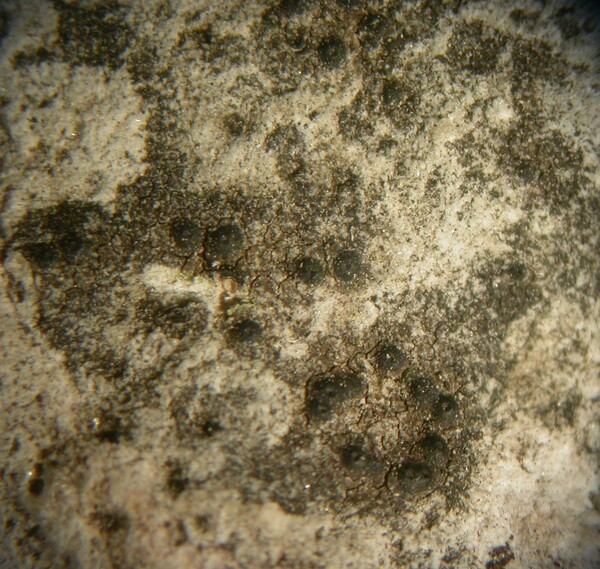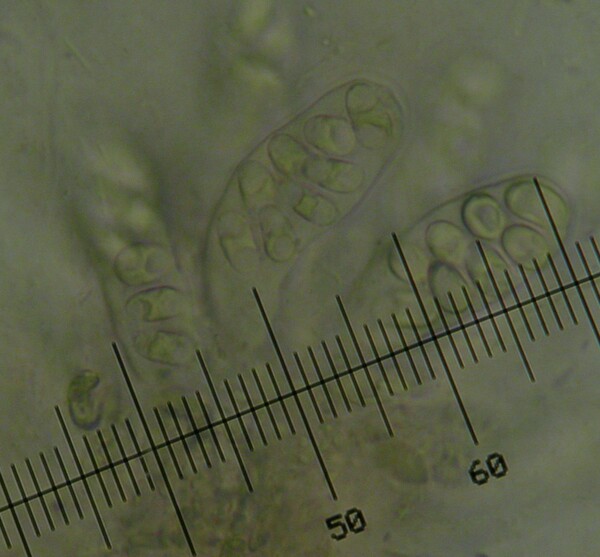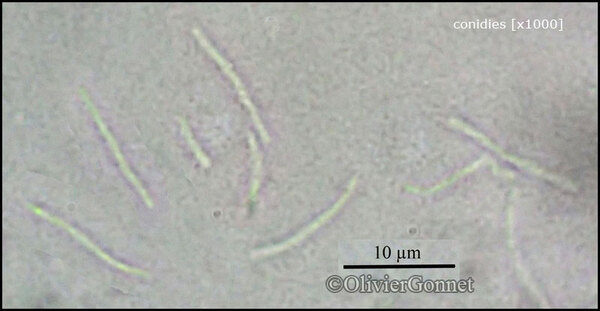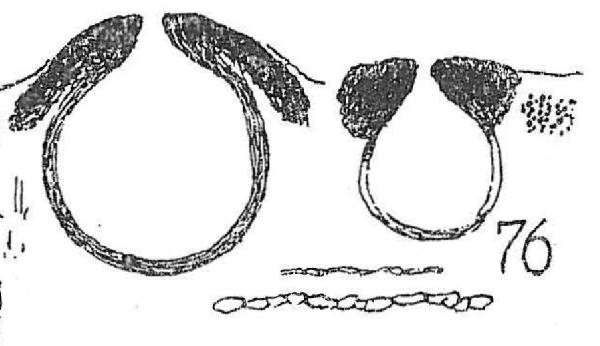Verrucaria fischeri Müll. Arg.
Flora, 51: 51, 1868.
Synonyms: Lithocia tristis A. Massal.; Lithocia tristis f. deformata A. Massal.; Verrucaria diffracta Anzi; Verrucaria tristis (A. Massal.) Kremp. non Hepp
Distribution: N - Frl, Ven (Caniglia & al. 1993, Nimis 1994, Nascimbene 2005c), TAA (Nascimbene & al. 2006, 2022, Nascimbene 2008b, Breuss & Berger 2012), Lomb, Piem (Isocrono & al. 2004), VA (Piervittori & Isocrono 1999), Lig. C - Abr.
Description: Thallus crustose, episubstratic, often forming irregular patches, thicker and cracked to minutely areolate in central part, thinner and often continuous in marginal parts, delimited by a dark brown prothallus, the areoles 0.2-0.5 mm wide (fertile ones up to 1 mm), brown to dark brown, often with a grey hue, rarely almost whitish. Cortex 40-50 μm thick, 2-layered, the upper layer of isodiametrical, thin-walled, angular cells, pigmented, the inner layer colourless; algal layer continuous, 50-100 μm thick; medulla poorly developed, without a black basal layer. Perithecia black, half immersed in the thallus, forming shallowly convex to conical-hemispherical projections. Involucrellum thick, often reaching to base-level, otherwise reaching at least the upper half, becoming thicker downwards (from 100-150 μm in the middle to 150-250 μm at base); exciple (0.2-)0.3-0.45 mm across, globose, the wall pale brown to finally (only in old perithecia) brown; hamathecium of c. 20 μm long periphyses and periphysoids, interascal filaments absent; hymenial gel hemiamyloid, I+ red (I+ blue at very low concentrations of I), K/I + blue. Asci 8-spored, pyriform to obovate, I-, fissitunicate, the wall thickened above, with an ocular chamber, dehiscent by extrusion of an endotunica to form a delicate rostrum, Verrucaria-type. Ascospores 1-celled, hyaline, globose to broadly ellipsoid, 8-10(-14) x 6-9 μm, with a thick wall (up to 1 μm). Pycnidia rare, black. Conidia (6-)8-13 μm long. Photobiont chlorococcoid. Spot tests: K-, C-, KC-, P-, UV-. Chemistry: without lichen substances.
Note: on steeply inclined faces of compact limestone and dolomite in open habitats, mostly above treeline. All earlier and recent (e.g. Grillo 1998) records from Southern Italy, and that from Tuscany (see Nimis 1993: 749), being very dubious, are not accepted here. Most Italian records should be checked against the very similar V. finitima and V. poeltii (see Breuss & Berger 2012). The species does not belong to Verrucaria and seems to be related to Staurothele (Gueidan & al. 2007).
Growth form: Crustose
Substrata: rocks
Photobiont: green algae other than Trentepohlia
Reproductive strategy: mainly sexual
Commonnes-rarity: (info)
Alpine belt: rather common
Subalpine belt: rather rare
Oromediterranean belt: absent
Montane belt: absent
Submediterranean belt: absent
Padanian area: absent
Humid submediterranean belt: absent
Humid mediterranean belt: absent
Dry mediterranean belt: absent

Predictive model
Herbarium samples
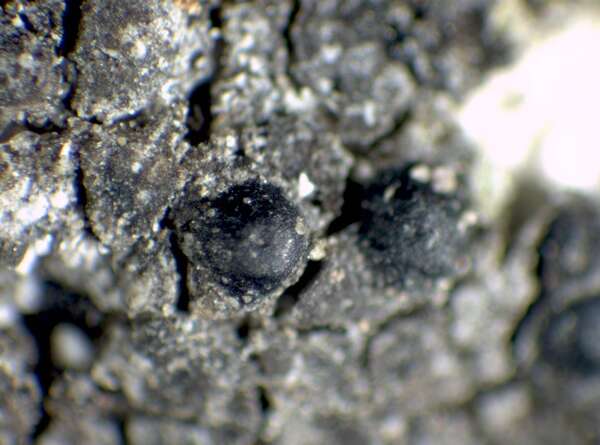

P.L. Nimis; Owner: Department of Life Sciences, University of Trieste
Herbarium: TSB (19716)
2001/12/03
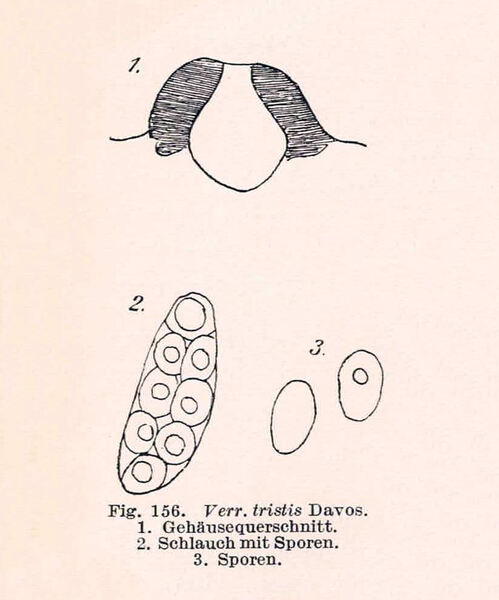
Zschacke, H. (1934) Epigloeaceae, Verrucariaceae und Dermatocarpaceae. In: Dr. L. Rabenhorst‘s Kryptogamen-Flora, Band 9, Abt. 1, Teil 1. Akademische Verlagsgesellschaft, Leipzig, 695 pp. - Public Domain
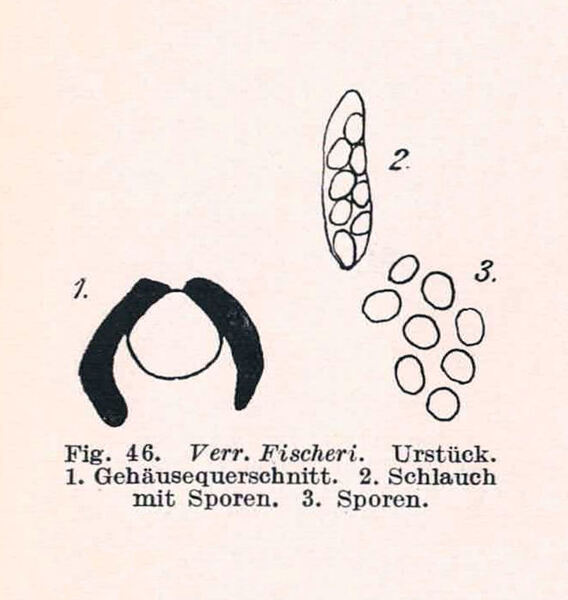
Zschacke, H. (1934) Epigloeaceae, Verrucariaceae und Dermatocarpaceae. In: Dr. L. Rabenhorst‘s Kryptogamen-Flora, Band 9, Abt. 1, Teil 1. Akademische Verlagsgesellschaft, Leipzig, 695 pp. - Public Domain
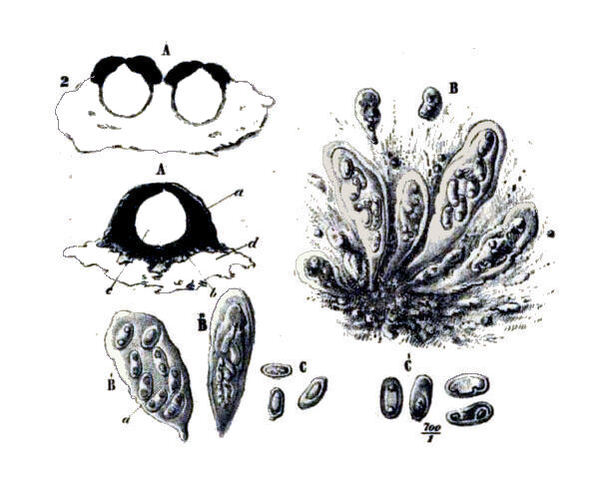
G. Gibelli, in S. Garovaglio, 1865 Tentamen Dispositionis Methodicae Lichenum In Longobardia Nascentium. Mediolanum
as Verrucaria tristis
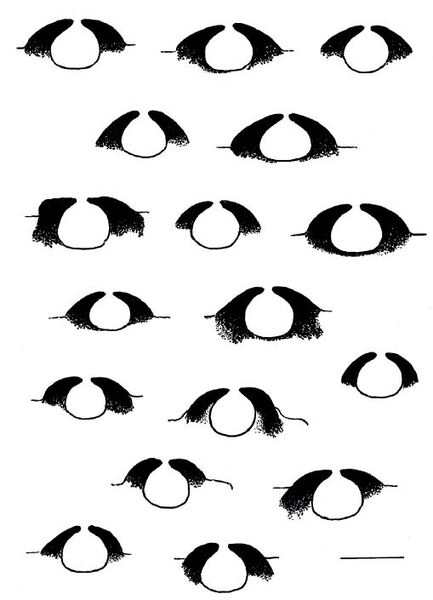
Source: • Breuss O., Berger F. 2012. Die Validierung von Verrucaria finitima und Bemerkungen über den Formenkreis von Verrucaria tristis (lichenisierte Ascomyceten, Verrucariaceae). Öst. Z. Pilzk., 21: 117-126.
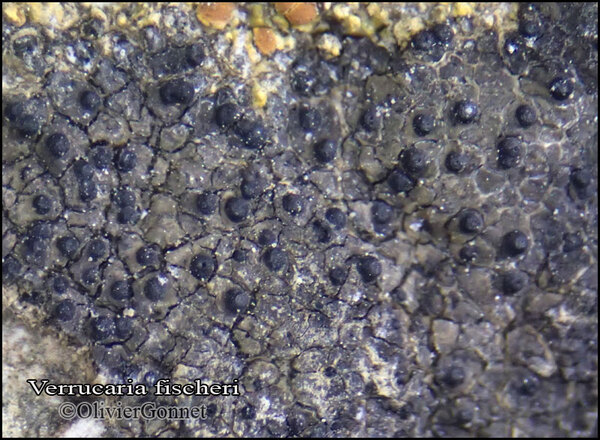
Courtesy Danièle et Olivier Gonnet - Source: https://www.afl-lichenologie.fr/Photos_AFL/Photos_AFL_V/Texte_V/Verrucaria_fischeri.htm
France, 4/9/2014 - Termignon, Bellecombe sentier GR alt. 2320 m - Savoie

Courtesy Danièle et Olivier Gonnet - Source: https://www.afl-lichenologie.fr/Photos_AFL/Photos_AFL_V/Texte_V/Verrucaria_fischeri.htm
France, 4/9/2014 - Termignon, Bellecombe sentier GR alt. 2320 m - Savoie
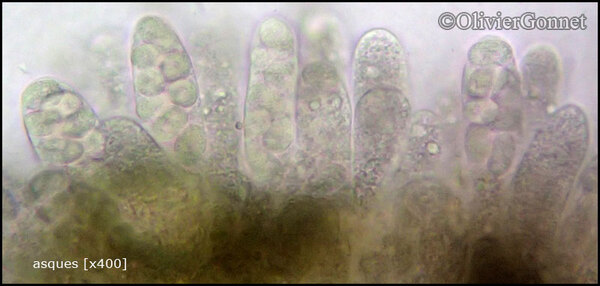
Courtesy Danièle et Olivier Gonnet - Source: https://www.afl-lichenologie.fr/Photos_AFL/Photos_AFL_V/Texte_V/Verrucaria_fischeri.htm
France, 4/9/2014 - Termignon, Bellecombe sentier GR alt. 2320 m - Savoie
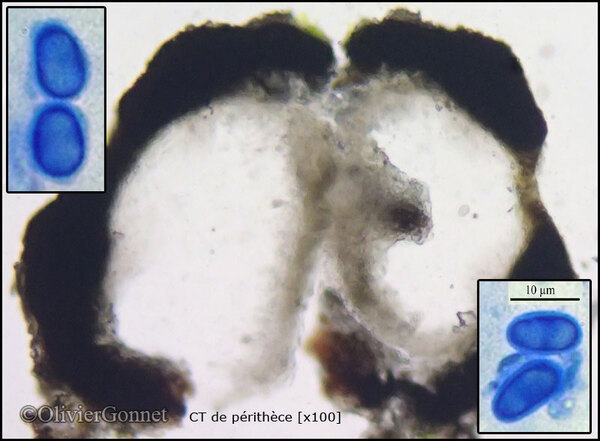
Courtesy Danièle et Olivier Gonnet - Source: https://www.afl-lichenologie.fr/Photos_AFL/Photos_AFL_V/Texte_V/Verrucaria_fischeri.htm
France, 4/9/2014 - Termignon, Bellecombe sentier GR alt. 2320 m - Savoie
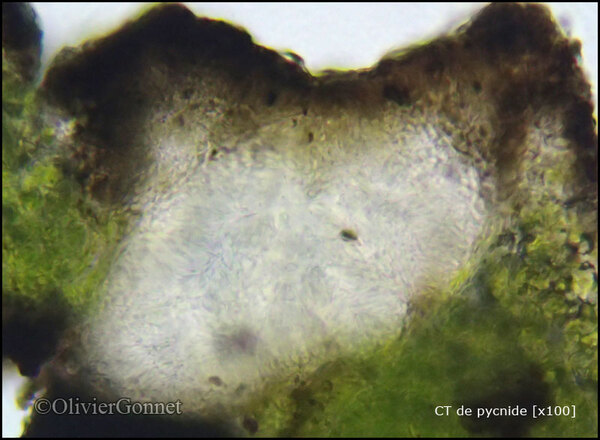
Courtesy Danièle et Olivier Gonnet - Source: https://www.afl-lichenologie.fr/Photos_AFL/Photos_AFL_V/Texte_V/Verrucaria_fischeri.htm
France, 4/9/2014 - Termignon, Bellecombe sentier GR alt. 2320 m - Savoie
Growth form: Crustose
Substrata: rocks
Photobiont: green algae other than Trentepohlia
Reproductive strategy: mainly sexual
Commonnes-rarity: (info)
Alpine belt: rather common
Subalpine belt: rather rare
Oromediterranean belt: absent
Montane belt: absent
Submediterranean belt: absent
Padanian area: absent
Humid submediterranean belt: absent
Humid mediterranean belt: absent
Dry mediterranean belt: absent

Predictive model
| Herbarium samples |


P.L. Nimis; Owner: Department of Life Sciences, University of Trieste
Herbarium: TSB (19716)
2001/12/03

Zschacke, H. (1934) Epigloeaceae, Verrucariaceae und Dermatocarpaceae. In: Dr. L. Rabenhorst‘s Kryptogamen-Flora, Band 9, Abt. 1, Teil 1. Akademische Verlagsgesellschaft, Leipzig, 695 pp. - Public Domain

Zschacke, H. (1934) Epigloeaceae, Verrucariaceae und Dermatocarpaceae. In: Dr. L. Rabenhorst‘s Kryptogamen-Flora, Band 9, Abt. 1, Teil 1. Akademische Verlagsgesellschaft, Leipzig, 695 pp. - Public Domain

G. Gibelli, in S. Garovaglio, 1865 Tentamen Dispositionis Methodicae Lichenum In Longobardia Nascentium. Mediolanum
as Verrucaria tristis

Source: • Breuss O., Berger F. 2012. Die Validierung von Verrucaria finitima und Bemerkungen über den Formenkreis von Verrucaria tristis (lichenisierte Ascomyceten, Verrucariaceae). Öst. Z. Pilzk., 21: 117-126.

Courtesy Danièle et Olivier Gonnet - Source: https://www.afl-lichenologie.fr/Photos_AFL/Photos_AFL_V/Texte_V/Verrucaria_fischeri.htm
France, 4/9/2014 - Termignon, Bellecombe sentier GR alt. 2320 m - Savoie

Courtesy Danièle et Olivier Gonnet - Source: https://www.afl-lichenologie.fr/Photos_AFL/Photos_AFL_V/Texte_V/Verrucaria_fischeri.htm
France, 4/9/2014 - Termignon, Bellecombe sentier GR alt. 2320 m - Savoie

Courtesy Danièle et Olivier Gonnet - Source: https://www.afl-lichenologie.fr/Photos_AFL/Photos_AFL_V/Texte_V/Verrucaria_fischeri.htm
France, 4/9/2014 - Termignon, Bellecombe sentier GR alt. 2320 m - Savoie

Courtesy Danièle et Olivier Gonnet - Source: https://www.afl-lichenologie.fr/Photos_AFL/Photos_AFL_V/Texte_V/Verrucaria_fischeri.htm
France, 4/9/2014 - Termignon, Bellecombe sentier GR alt. 2320 m - Savoie

 Index Fungorum
Index Fungorum
 GBIF
GBIF
